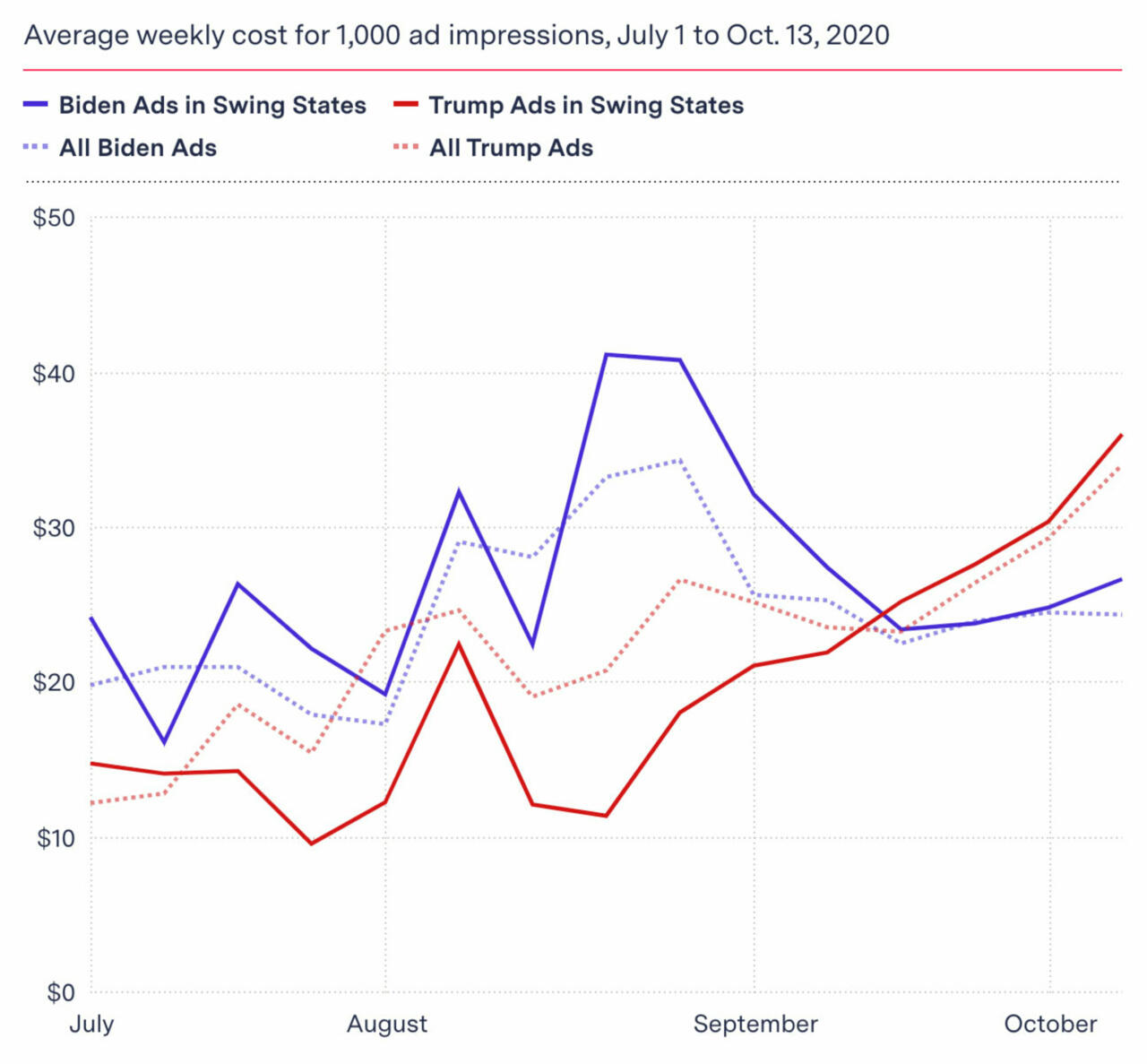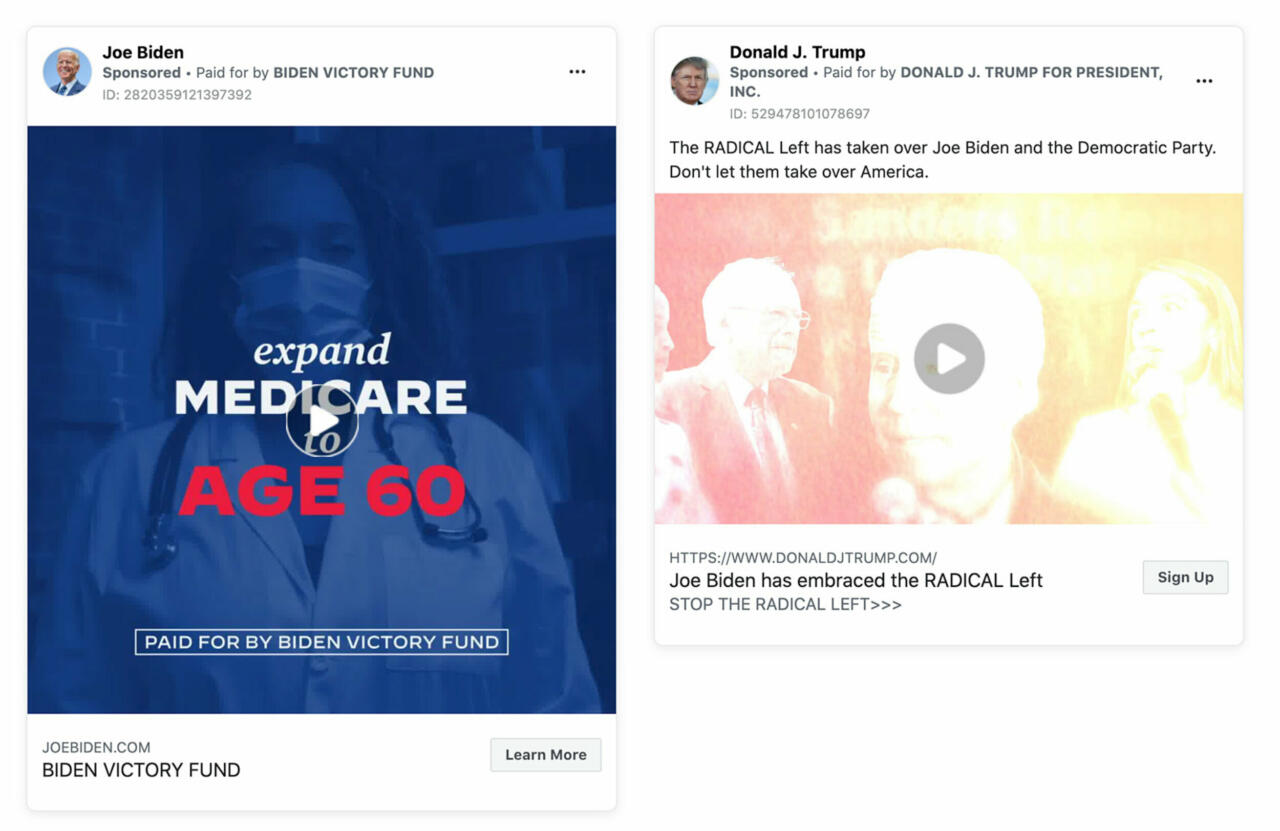Hello, friends,
You probably already know that Facebook’s black box algorithms decide what news is promoted or suppressed in your News Feed. But perhaps you didn’t know that Facebook also has opaque algorithms that determine the price of each advertisement it sells.
And it turns out that Facebook’s algorithmic pricing scheme has been giving the Trump campaign lower ad rates on average than the Biden campaign, according to our latest investigation, by Jeremy B. Merrill.
We found that President Trump paid rates that were about 11 percent lower on average than former vice president Biden’s during the period between July 1, 2020, and Oct. 13, 2020. The difference was starkest in ads shown mostly in swing states during July and August, when Trump paid, on average, less than half of what Biden paid, according to our analysis.
We based our analysis on ads published by Facebook’s Ad Library API and provided to The Markup by the NYU Ad Observatory. To calculate the ad rates—cost per 1,000 views, which are generally abbreviated as CPM (cost per mille)—we estimated the spend and impressions for each ad as the midpoint of the range reported by Facebook.
Of course, we have no reason to believe that Facebook’s pricing fluctuations are due to any kind of partisan bias. As with most digital platforms, Facebook’s prices are driven in large part by auctions in which different advertisers bid on different audiences.
In its public political ad library, Facebook does not disclose the characteristics of the audiences that each campaign was trying to reach. So we cannot tell how expensive those audiences might be—perhaps one campaign has cheaper audience targets than the other.
And there are many other factors that we can’t see either. For instance, Facebook says it judges ads using a “relevance” algorithm that gives cheaper prices to ads that are deemed to be more relevant to their audiences and are judged to be higher “quality.” “We subsidize relevant ads in auctions, so more relevant ads often cost less and see more results,” Facebook tells advertisers.
The resulting price differences can be striking.
When Trump wanted to reach out to older Arizona voters in August with the message “The RADICAL Left has taken over Joe Biden and the Democratic Party,” with photos of Bernie Sanders, Alexandria Ocasio-Cortez, and Ilhan Omar, Facebook charged his campaign an estimated $14 for each 1,000 times the advertisement appeared in people’s feeds.
A few days later, Biden targeted a similar demographic with a message of his own, that he had a plan to expand Medicare and cut drug prices. But Facebook charged him a very different price—an estimated $91 per 1,000 views of his ad, more than six times what Trump’s ad had cost.
Since we can’t see the inputs, we can’t guess which ones caused the price difference. The audiences could have been different Arizona seniors, or there could have been more competition for Arizona seniors’ attention during different days.
If a television station used similar pricing schemes—charging one candidate more for a message than another because it was more “relevant” or the audience was more distracted on a given day—it would be illegal. The Federal Communications Commission requires TV stations to charge candidates the same price for ads, the lowest that they charge any advertiser.
Internet ads, however, are not regulated in a similar fashion. As a result, Biden’s higher average price means he has likely paid more than $8 million more for his Facebook ads than he would have if he had been paying Trump’s average price.
Biden, who has a cash advantage over Trump, can afford to pay a premium. But for other political candidates, a multimillion-dollar price disparity could be devastating. As Ann Ravel, a former commissioner of the Federal Elections Commission, told Jeremy, some candidates “could get an advantage that other candidates wouldn’t get.”
Campaign experts say this type of pricing can incentivize ads that are more controversial—because they can trigger more “engagement.”
Gary Coby, the digital director of the Trump campaign, tweeted in response to our piece, “… we also have a candidate edge — More ppl want to watch a Trump video.”
Rob Flaherty, Biden’s digital director, attributed the pricing difference to a different strategy, tweeting that different campaigns “target different audiences for different reasons with different strategies and in so doing pay different prices.”
Republican digital campaign strategist Eric Wilson tweeted, “Auction-based advertising leads to these discrepancies and incentivizes campaigns to play to the algorithm. Social ads should have a fixed rate amongst candidates just like every other medium.”
Facebook defended its fluctuating ad pricing. “This article reflects a misunderstanding of how digital advertising works. All ads, from all advertisers, compete fairly in the same auction. Ad pricing will vary based on the parameters set by the advertiser, such as their targeting and bid strategy,” Joe Osborne, a Facebook spokesperson, told The Markup in an emailed statement.
But, as Congress considers regulating tech companies, it’s worth thinking about whether we—the public—want to continue to exempt tech companies from the fairness requirements we have set for political advertising in other media.
Thanks, as always, for reading.
Best,
Julia Angwin
Editor-in-Chief
The Markup

